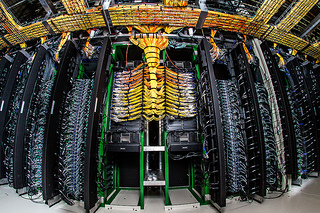Washington, D.C. — One of the world’s fastest, most energy-efficient supercomputers – expected to help energy researchers discover new materials, optimize designs and better predict operational characteristics – is up and running at the Office of Fossil Energy’s National Energy Technology Laboratory (NETL) in Morgantown, W.Va.
|
|
 |
|
NETL's new supercomputer, installed at the Simulation-Based
Engineering User Center, is a powerful and energy-efficient
modeling tool. | |
The High-Performance Computer for Energy and the Environment (HPCEE) is not only on the TOP500 list as one of the top 100 supercomputers in the world—currently ranked at 55—but it is also one of the most energy efficient for its size.
Housed at NETL’s Simulation-Based Engineering User Center, the supercomputer is a 503 TFlops (trillion floating-point operations per second) computer that enables the simulation of phenomena that are difficult or impossible to measure, such as coal jet penetration into a gasifier. With capabilities for running modeling tools at various scales ranging from molecules, to devices, to entire power plants and natural fuel reservoirs, the HPCEE is the backbone for providing enhanced visualization, data analysis, and data storage capabilities.
All of the computational, visualization, network hardware, and primary storage servers are installed in a Silicon Graphics ICE Cube® Air modular data center. This datacenter provides the HPCEE one of the lowest power utilization efficiency (PUE) infrastructures available, with a range of 1.01 to 1.1 PUEs. To date, the HPCEE has one of the lowest recorded PUEs achieved in the industry, using only one percent of total electrical consumption to cool the equipment—far surpassing the DOE Office of the Chief Information Officer’s standard of 40 percent. The increase in efficiency translates to electrical energy cost savings of approximately $450,000 annually.
- End of Techline